
NORTHWEST SCIENCE
Scope & Guideline
Empowering researchers with vital insights from the Northwest.
Introduction
Aims and Scopes
- Ecological Research and Biodiversity:
The journal focuses on studies that assess and document biodiversity, including species distribution, habitat preferences, and ecological interactions within the Pacific Northwest. This includes both flora and fauna, with an emphasis on threatened and endemic species. - Environmental Impact Studies:
Research published in NORTHWEST SCIENCE often evaluates the effects of human activities, such as dam removal, urbanization, and agricultural practices, on local ecosystems. This includes studies on habitat restoration, species recovery, and the resilience of ecosystems to anthropogenic changes. - Climate Change and Ecological Responses:
The journal explores how climate change impacts ecological dynamics, including species migration, phenology, and habitat alteration. Studies may include long-term monitoring and modeling of ecological responses to changing climatic conditions. - Cultural and Historical Ecology:
NORTHWEST SCIENCE recognizes the importance of cultural perspectives in ecological research, often publishing papers that explore the intersection of ecological science with indigenous knowledge and historical land use practices. - Conservation Strategies and Management Policies:
The journal addresses conservation efforts and policy implications by publishing research that informs sustainable management practices and policy decisions for natural resources in the Pacific Northwest.
Trending and Emerging
- Ecological Restoration and Management:
There is a growing emphasis on research that addresses ecological restoration techniques and their effectiveness. This includes studies on habitat restoration following disturbances, such as dam removals and wildfire recovery, reflecting an urgent need for actionable conservation strategies. - Impact of Climate Change on Ecosystems:
Research exploring the impacts of climate change on species distributions, ecological interactions, and habitat changes is increasingly prominent. This includes studies on phenological shifts and adaptive management practices to mitigate climate-related challenges. - Urban Ecology and Human-Wildlife Interactions:
With urbanization on the rise, studies examining the dynamics of urban ecosystems and the interactions between wildlife and humans are gaining traction. This includes assessments of biodiversity in urban settings and the effects of urban development on local species. - Aquatic Ecosystems and Freshwater Biodiversity:
There is a notable increase in research focusing on freshwater ecosystems, particularly concerning fish communities, aquatic plants, and the impacts of hydrological changes. This trend highlights the importance of freshwater biodiversity in the Pacific Northwest. - Integrative Approaches to Conservation:
Research that integrates ecological, social, and economic perspectives in conservation planning is becoming more common. This reflects a holistic understanding of the complexities involved in managing natural resources and fostering sustainable practices.
Declining or Waning
- Traditional Taxonomy Studies:
Research focused solely on traditional taxonomic classifications has decreased. While taxonomy remains important, there is a growing trend towards integrative approaches that combine genetic, ecological, and behavioral studies, leading to less emphasis on classic taxonomic descriptions. - Historical Ecology Without Modern Context:
Papers that solely focus on historical ecological conditions without integrating contemporary ecological challenges or management implications are less frequent. There is a shift towards research that links historical data with current environmental issues and conservation strategies. - Generalist Studies of Common Species:
Research on common or widely distributed species has declined, as there is a stronger focus on conservation concerns for threatened and unique species that require immediate attention and resources. - Purely Descriptive Studies:
There is a noticeable reduction in purely descriptive ecological studies that do not offer insights into management or conservation actions. The journal is increasingly prioritizing research that provides actionable recommendations based on ecological findings.
Similar Journals

RUSSIAN JOURNAL OF ECOLOGY
Navigating the Complexities of Ecology in Russia and BeyondRUSSIAN JOURNAL OF ECOLOGY, published by PLEIADES PUBLISHING INC, stands as a critical resource within the field of ecology, offering an array of research insights that span various ecological topics. With an ISSN of 1067-4136 and an E-ISSN of 1608-3334, this journal has been consistently disseminating knowledge since its inception in 1996, now converging towards 2024. Despite its current Q4 ranking in the Ecology, Evolution, Behavior and Systematics category, the journal has carved out a niche in the publication landscape, particularly for scholars focused on the rich and diverse ecological phenomena of Russia and surrounding territories. The journal aims to foster interdisciplinary collaboration and innovation by providing a platform for the dissemination of high-quality research. While it currently lacks open access options, readers can expect in-depth studies and analytical discourses that contribute meaningfully to the global understanding of ecological systems. With an impressive Scopus rank, this journal remains an important outlet for researchers, professionals, and students committed to advancing ecological science.

PACIFIC CONSERVATION BIOLOGY
Elevating conservation discourse with impactful findings.PACIFIC CONSERVATION BIOLOGY is an esteemed academic journal published by CSIRO PUBLISHING, dedicated to advancing research in the fields of ecology and nature conservation. With a strong focus on the unique challenges and biodiversity of the Pacific region, this journal serves as a crucial platform for researchers, conservationists, and students alike to disseminate high-quality, impactful findings. Operating from Australia, it has become a significant resource since its inception in 1993, navigating through nearly three decades of vital scholarly communication. Ranked in the Q2 category for both Ecology and Nature and Landscape Conservation as of 2023, PACIFIC CONSERVATION BIOLOGY maintains rigorous standards, as reflected in its successful Scopus rankings. The journal plays a pivotal role in addressing pressing ecological issues and fostering innovative conservation strategies, making it an essential reference for anyone involved in environmental science. Access options for the journal facilitate widespread distribution of knowledge, supporting the mission to promote informed decision-making in conservation practices.
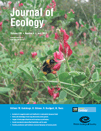
JOURNAL OF ECOLOGY
Shaping the future of ecological research and discourse.JOURNAL OF ECOLOGY, published by Wiley, stands as a leading publication in the field of ecology, evolution, behavior, and plant science, currently positioned in the prestigious Q1 quartile across these categories. Established in 1976, the journal has consistently provided a platform for innovative research and critical discourse related to ecological patterns, processes, and interactions. With its robust Scopus ranking—31st out of 721 in Ecology, Evolution, Behavior and Systematics, and 26th out of 516 in Plant Science—this journal notably reflects the high impact and influence of its articles in the scientific community. Although it does not offer open access options, the journal ensures comprehensive dissemination of pivotal findings to researchers, professionals, and students alike. Located in the United Kingdom at 111 River St, Hoboken, NJ, the JOURNAL OF ECOLOGY remains an essential resource for those dedicated to advancing our understanding of ecological systems and their complexities.
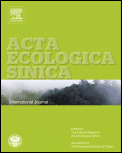
Acta Ecologica Sinica
Empowering scholars to shape the future of ecological science.Acta Ecologica Sinica, published by Elsevier, is a prominent journal in the field of ecology, with a strong focus on fostering understanding in ecological principles and their applications. Established in China, this journal holds an impressive Q2 categorization in both Ecology and Ecology, Evolution, Behavior and Systematics as of 2023, positioning it within the top tier of ecological research. With its Scopus rankings placing it in the 81st and 78th percentiles in relevant ecological domains, it serves as a vital platform for researchers and practitioners to disseminate findings that promote ecological sustainability. Although it operates under a traditional access model, its significant impact is underscored by its systematic convergence of key ecological inquiries across multiple years (2006-2008, 2014, 2017-2023). By engaging with the latest empirical studies, theoretical advancements, and methodological innovations, Acta Ecologica Sinica is indispensable for scholars dedicated to advancing ecological knowledge and addressing environmental challenges.
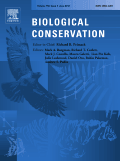
BIOLOGICAL CONSERVATION
Elevating Conservation Efforts with High-Impact Findings.BIOLOGICAL CONSERVATION, published by Elsevier Science Ltd, is a leading international journal dedicated to advancing the science and practice of biological conservation. Since its inception in 1968, the journal has provided a critical platform for researchers, professionals, and students in the fields of Ecology, Evolution, Behavior, and Systematics as well as Nature and Landscape Conservation. With an impressive impact factor, and ranked in the Q1 category within both ecological and conservation domains in 2023, it emphasizes high-quality empirical and theoretical research essential for understanding and addressing pressing environmental challenges. Although it follows a subscription model, the journal is known for its rigorous peer-reviewed articles that contribute significantly to the field, ensuring that the latest findings and methodologies are readily accessible to practitioners. As a vital resource for those engaged in conservation efforts globally, BIOLOGICAL CONSERVATION stands out for its commitment to enhancing knowledge and informing strategies that safeguard biodiversity across ecosystems.

REVISTA CHILENA DE HISTORIA NATURAL
Connecting Research, Conservation, and EducationREVISTA CHILENA DE HISTORIA NATURAL, published by the SOCIETAD BIOLOGIA CHILE, is an esteemed open-access journal dedicated to the fields of Agricultural and Biological Sciences as well as Environmental Science. With an ISSN of 0716-078X and an E-ISSN of 0717-6317, the journal has maintained an impactful presence since its inception in 2000, offering unrestricted access to vital research that influences the biodiversity and ecological initiatives in the region and beyond. Positioned in the Q2 quartile for Agricultural and Biological Sciences and Q3 for Environmental Science as of 2023, REVISTA CHILENA DE HISTORIA NATURAL exemplifies its commitment to high-quality and influential research, evidenced by its respectable ranking in Scopus—89th percentile for Agricultural and Biological Sciences and 131st in Environmental Science. Operated out of Santiago, Chile, and covering a wide range of topics with a converging publication timeline from 2002 to 2024, this journal serves as a crucial resource for researchers, professionals, and students looking to deepen their understanding of natural history and its implications for future ecological preservation.
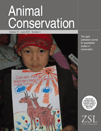
ANIMAL CONSERVATION
Innovating Conservation Strategies for Wildlife and Habitats.Animal Conservation is a prestigious journal that serves as a vital platform for the dissemination of research dedicated to the preservation of wildlife and habitats. Published by Wiley, this journal has established a significant presence in the fields of Ecology and Nature and Landscape Conservation, holding a distinguished Q1 category ranking for both in 2023. With an impressive Scopus rank of #25 in the realm of environmental science, it caters to a global audience keen on understanding and addressing pressing conservation issues. The journal provides researchers, professionals, and students with high-quality, peer-reviewed articles that explore innovative methods and strategies in animal conservation. With its continuous publication since 1998, encompassing a comprehensive range of topics, Animal Conservation is indispensable for anyone aiming to make impactful contributions to the field of ecology and conservation biology.

NEW ZEALAND JOURNAL OF ECOLOGY
Advancing Insights in Ecology and Environmental ScienceNEW ZEALAND JOURNAL OF ECOLOGY, published by the New Zealand Ecological Society, stands as a premier platform for disseminating research in the field of ecology, with a notable impact factor reflected in its Q2 ranking in multiple ecology categories for 2023. Established in 1980 and actively publishing since 1982, this journal provides a vital resource for ecologists and environmental scientists, fostering the exchange of innovative ideas and methodologies. The journal covers a wide range of ecological topics, ensuring a comprehensive overview of the current trends and research developments in both ecological theory and practical applications specific to New Zealand and beyond. Researchers, professionals, and students will find in this journal an authoritative source to advance their understanding of ecological dynamics and contribute to the growing field of ecological science. The journal is accessible to the community without open access, providing critical insights that underpin the ecological landscape of New Zealand and inform sustainable practices worldwide.
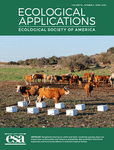
ECOLOGICAL APPLICATIONS
Transforming ecological theory into practice.ECOLOGICAL APPLICATIONS, published by WILEY, is a leading journal in the field of ecology, providing a platform for innovative research that addresses the understanding and management of ecological systems. With an ISSN of 1051-0761 and E-ISSN of 1939-5582, it has established itself as a vital resource for ecologists and environmental scientists since its inception in 1991. Ranked in the top quartile (Q1) for Ecology in 2023 and with a Scopus ranking of 40 out of 461 in Environmental Science, ECOLOGICAL APPLICATIONS boasts an impressive impact factor, attesting to its significance and influence in the field. The journal's mission is to publish peer-reviewed articles that contribute to ecological theory and its applications in conservation and environmental management. Researchers, professionals, and students alike will find invaluable insights and the latest developments in ecological research through its comprehensive scope and rigorous scholarship, ensuring a crucial role in shaping future ecological practices and policies.
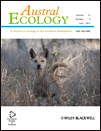
AUSTRAL ECOLOGY
Advancing ecological insights from the Southern Hemisphere.AUSTRAL ECOLOGY, published by WILEY, is a key journal in the field of ecology, with a focus on ecological research from the Southern Hemisphere and beyond. With an ISSN of 1442-9985 and an E-ISSN of 1442-9993, this journal serves as a vital platform for the dissemination of significant findings related to ecology, evolution, behavior, and systematics. Currently holding a commendable Q2 ranking in both Ecology and Ecology, Evolution, Behavior and Systematics categories as of 2023, AUSTRAL ECOLOGY is recognized for its rigorous peer-review process and impactful research contributions, as evident from its Scopus rankings in the 56th percentile for both Agricultural & Biological Sciences and Environmental Science. Researchers, professionals, and students engaged in ecological studies can benefit from the journal's open access options, enabling wider accessibility to critical ecological insights and advancements in the field. Established in 1981, with an evolving legacy through its converged years from 1996 to 2024, AUSTRAL ECOLOGY remains committed to advancing ecological knowledge and fostering a deeper understanding of ecological dynamics in our ever-changing environment.